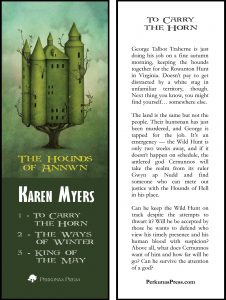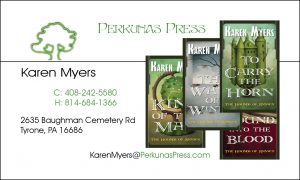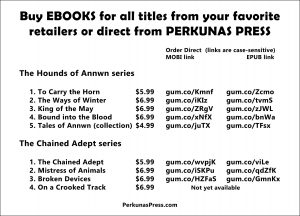 Whenever we send someone a book directly, or sell one at an event, we have an opportunity to include other things. Most commonly, these are bookmarks, which we also distribute wherever we can.
Whenever we send someone a book directly, or sell one at an event, we have an opportunity to include other things. Most commonly, these are bookmarks, which we also distribute wherever we can.
Business cards are also very useful to carry when you're meeting people, or standing around at a convention.
What are they good for? How can we make them maximally effective?
Why bookmarks?
Bookmarks are the stand-alone representations of your books. They're popular as leave-behinds in bookstores or at group events, and are the obvious choice for inserts into your books when you sell directly (via online ordering or at trade shows/events).
There is debate about whether all bookstores want them, but many do. If you're not sure, ask.
What's the goal of a bookmark? To interest someone in buying another book. You can't list all your books on a bookmark, as though it were a mini-catalogue. That may seem plausible when you only have one or two books, but it defeats the purpose of seducing the reader with well-designed, professional information.
Instead, set up one bookmark for each series or important stand-alone book. Remember, when you start a series, you may not know how many books there will be, or what their names are. I created the bookmark above (using cover art from the first book) before I wrote a fourth entry and a story collection.
Focus on the first book of the series, name as many of the other books as you can without muddying up the image, and refer to “… and more” after that point. If you create a new bookmark for each series, you can be inventive about including a bookmark for series 2 in a book sale for series 1 to encourage cross-sales. Whenever you have any reason to mail something to someone, include a bookmark and a business card.
And since you may write faster than you use up a print run of bookmarks, future-proof them by using only digital contact information bits, not physical ones. I've moved since I made that bookmark, and I expect to move again before I run out of them.
Why business cards?
 Let's be blunt. If you're in business and you don't have business cards, how do you expect to support a professional impression? A business card is a courtesy to a potential buyer or colleague or vendor. It keeps them from having to write down your contact information themselves.
Let's be blunt. If you're in business and you don't have business cards, how do you expect to support a professional impression? A business card is a courtesy to a potential buyer or colleague or vendor. It keeps them from having to write down your contact information themselves.
Better yet, it's another opportunity to sell your product and seduce potential buyers.
Remember, you have more than one persona as an indie author. You are a writer, and you are also a publisher. Those are different roles and require different websites, and that means different business cards. (See here for Author vs Publisher websites.)
My publisher (me) is Perkunas Press. I created the above card a couple of years ago, and I now have three series and nine novels to offer (so far), so I'll be re-designing these cards soon. They use the branding elements for the business, of course, and as much colorful material from my book covers at the time to make a pleasant impression.
The covers by themselves should convey the genre (fantasy) without explicit statement, but certainly declaring your genre(s) on your card can't hurt.
UPDATE: I've added cards for my readers website (KarenMyersAuthor),  and my writing colleagues website, HollowLands (this one).
and my writing colleagues website, HollowLands (this one).
I left the backs bare and unglossy to allow people to write on them, a useful tip from my decades in the corporate world. When you meet someone, you write info about them on the back of their card — reminders, action items, etc. When you give someone a card, you can add more details on the back, such as a time/place to get together.
Next time, I'll do what many commercial ad agencies do — I'll add different artwork to the back of the cards, varying by series. Each artwork will feature the first book of a series, with brief series info, rather like miniature bookmarks. If three people drop by your event, and each gets a card with a different back, they'll compare them and talk about it — just what you want.
Other stationary components
As long as we're on the subject, what about the other, minor components of your stationary?
Invoices
No matter how simple and unsophisticated, things like invoices need branding/contact info. Products like QuickBooks will help you set that up.
Correspondance & Shipping
 Make up a sheet of Avery labels to stick on your envelopes or packages.
Make up a sheet of Avery labels to stick on your envelopes or packages.
Sometimes you just have to write letters. Why not set up a Word document template?
Ebook sales cards
These are cards that represent your ebooks when you're at an event selling print editions. A few years ago, several vendors created these cards as hanger-cards for retail sites, allowing a customer to buy the card at the counter, then go home and enter a unique code from the card to receive the ebook.
Since then, the few vendors that offer these have decided to focus on bulk buyers, leaving a vacuum for authors wanting a way to sell ebooks at events. I am exploring a free postcard-sized item that provides links to all my ebooks at my ecommerce vendor (Gumroad), where they would have to then pay for them, or a sellable card that points them at BookFunnel, a site that specializes in free giveaways (not ecommerce or money collection) and provides excellent support for email contact collection for mailings and for user ebook download issues. If I take the latter route, I would sell the cards for money at events, and make sure the buyer can contact me for any issues. There are downsides: potential copying of link codes, until the link expires being the largest, but also the issue of providing cards for each product for sale, per event (to allow for expiring links). I'm still working out what the best approach is.
In any case, an ebook sales card should be attractive, clear, and secured at an event (they're worth money).
UPDATE: I decided to go with a straight direct purchase from my ecommerce vendor for now, on a fancy 5″x7″ card.
Other
Event banners. Strictly speaking, these are marketing items rather than stationary.
Pens. Get the highest quality you can reasonably afford, in colors compatible with your branding. Don't give them away casually, like business cards or bookmarks, but leave a few by your Newsletter Signup book and don't complain when they walk away. (If they like them well enough to lift them, they'll keep reading the message.)
Make the most of the message space. The limitations on the text will make you distill it down to its essence. Mine say:
Meet Heroes in Far-Away Places
Fantasy & SciFi by KAREN MYERS
HollowLands.com
Magnets. They're pricey, but if you can ensure they end up on the right refrigerators, maybe it's a good deal.
Mini-books. Miniature images of your books, suitable for doll-houses.





Great advice thanks. I’m about to design my business cards and your article has given me lots to think about. I like your Hollow Lands business card – it stands out and piques my curiosity. Thanks again, Deb
Glad I could help. A lot of stationary elements are involved in any business, and we tend to forget about them until forcibly reminded. Might take two or three tries before you end up with something you like for the long haul.
[…] Karen will be returning again next month with a similar piece about how to produce the best business cards for indie authors. There’s a longer article about book marketing stationery for authors on her website here. […]
[…] Karen Myers has a longer post about business card, bookmarks and other business stationery for authors on her author blog here. […]
Very useful post. Thank you.
I often sell one of my books as a signed copy which I post directly to the buyer/reader. I’m thinking it would be nice to include a bookmark. Do you recommend including a bookmark that relates to the book I’m selling, or one advertising another book?
That depends… If you do one bookmark per series, then if the book is not the last of the series, I would tend to include the one for that series as a reminder. If the book is the last of its series, then a bookmark for another series.
Why not include both?
I cannot, for the life of me, figure out what the C: and H: before your phone numbers are. Sorry to be so dense!
Your cards look so professional. Do you give a lot of them out?
Do you have bulk sales, etc.?
Cell, Home, (Business, Work, Fax, Mobile) — those are the usual abbreviations in the business world. As you can see, there are some choices, since they’re all uniquely-initialled.
I hand out Perkunas Press cards whenever I’m somewhere that it makes sense. When I re-do the HollowLands ones, I’ll do the same with those.
Haven’t had a bulk sale, in the sense of a commercial order from a bookstore or event, but I’ve provided inventory for several local stores in Virginia, esp. for my first series which has a foxhunting/riding tie-in (to both bookstores in foxhunting country and literate tack shops).